Basil is one of the most well-known and loved herbs to grow at home. It is a beginner-friendly herb that can help you learn some useful gardening techniques, but it is also a favorite among experienced gardeners because of its versatility.
I have learned a lot about growing basil over the years. Primarily from a lot of hands-on experience but also from talking to a bunch of different gardeners and people working at plant nurseries or garden centers, and other experts.
I have written this post to provide a complete resource with everything you need to know about growing and caring for basil. I cover everything you need to know for the entire growing season from sowing the seeds to giving your plants the best growing conditions, solving common problems, harvesting and storing them, and much more.

First, some key facts and tips about basil and how to grow it.
| Botanical name | Ocimum basilicum |
| Flowering time | Summer |
| Frost tolerant | No |
| Plant size | 6-36 inches (15-90 cm) depending on the variety. Most varieties are between 12-24 inches (30-60 cm) |
| Sunlight | 6-8 hours of direct sunlight per day. Morning sun is better than afternoon sun |
| Watering | Water lightly whenever the top of the soil is dry |
| Soil | Nutrient-rich, well-drained soil with a pH between 6.0-7.5 |
| Fertilizer | Fertilize sparingly. Mix a liquid 5-10-5 NPK fertilizer into the water every 4-6 weeks |
| Spacing | 3-5 plants per 8-inch pot or 3-5 plants together per group in the ground. 12 inches between groups in the ground |
I cover absolutely everything you need to know about basil and how to grow it, care for it, harvest it, and much more in this post, so if you want, you can bookmark it so you can come back when you run into new questions as your plants grow. Here is a quick overview of what I cover:
- Basil Planting Tips (Choosing a variety, growing from seed, best time, best place, transplanting, pot vs. ground, and indoors vs. outside)
- Best Growing Conditions for Basil (Sunlight, temperature, watering, soil, fertilizer, spacing)
- Caring for Basil (Pruning, propagation, flowering, seed collection, and companion planting)
- Common Basil Problems and What to Do About Them (Root rot, rootbound, mold, leaves not growing, aphids, whiteflies, spider mites, powdery mildew, downy mildew)
- Tips for Harvesting and Storing Basil
- Common Questions About Growing Basil
Basil Planting Tips (Varieties, Pot vs. Ground, and More)
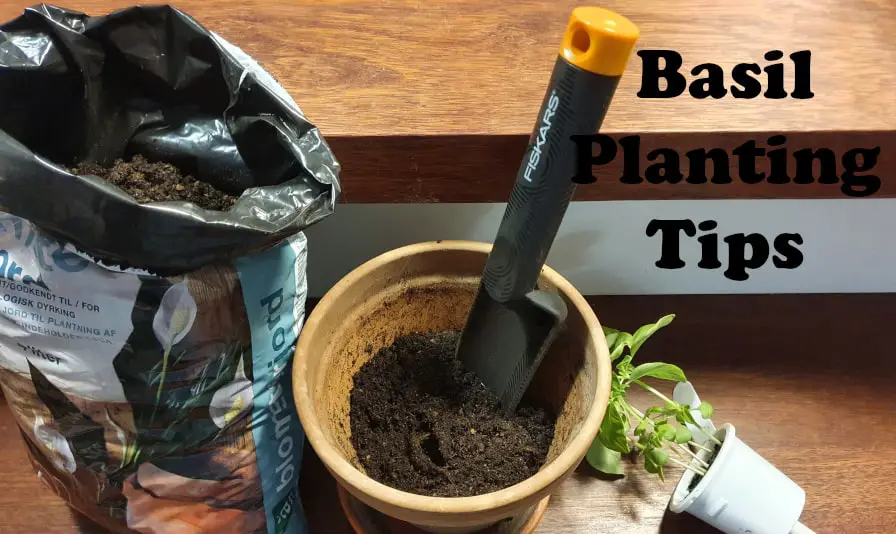
Basil is a fairly easy herb to grow, but there are many things you can do that will make your basil plants grow a lot better and faster and produce a lot more leaves. Most of these things are easy and done just once when you plant your basil and will make an enormous difference in how fast it grows and how big and productive it gets.
Below, I explain everything you need to know about planting basil, including how to choose a variety, finding the perfect spot for your plant, the best method for sowing basil seeds, and transplanting basil to a pot or into the ground. I also discuss the differences and advantages and disadvantages of growing basil in a pot compared to in the ground as well as indoors compared to outside, so you can find out precisely what works for you.
Choosing a basil variety
Choosing a basil variety can be confusing because there are so many, so I have written this to make it easier for you.
It is estimated that there are upwards of around 150 basil varieties, each with unique characteristics and properties.
When you begin to grow basil, you should pick one or a few varieties that fit your needs and preferences, but if variety selection is a bit too much to wrap your head around, then just go with a Genovese basil.
Genovese basil (also often called sweet basil) is the most common variety and usually the one you see in supermarkets and other stores. I almost only grew Genovese basil for a few years before I started with different varieties, but now I always make sure to grow at least a few different ones.
You should also know that some basil varieties are annuals, meaning that they only live for up to a year, and others are perennial, which means that they can live for multiple years. You can read more about that on this link.
There is a huge difference in size, shape, smell, and taste when it comes to different basil varieties, so having some idea of what the difference between varieties are can help you find the right variety for you. That’s why I have made a list of some popular varieties with a few details about each to help you decide which one is right for you.
- Genovese basil. The classic green “pesto basil” you see in most stores.
- Thai basil. The leaves are smaller and pointier and taste a little bit spicier than the classic Genovese basil. The flowers are dark purple which creates a beautiful contrast to the green leaves.
- Spicy globe basil. A small and dense variety with tiny leaves. It grows as a tight little shrub so it is great for growing in a pot or container, but it also grows and looks great when growing directly in the ground.
- Lettuce leaf basil. This variety grows huge leaves with a length of 5 inches (12.7 cm). The leaves don’t taste as strong as many other basil varieties which makes them perfect for using in salads or as a fun garnish.
- Dark opal basil. Instead of having some shade of green which most basil varieties do, dark opal basil has a deep, dark purple color. A small portion of the leaves or so will be green as they don’t contain the component that makes them purple, which makes the whole plant very aestetically pleasing to look at. The taste is similar to the classic genovese basil, but usually a bit milder.
- African blue basil. One of the few basil varieties that are perennial, which means it can live for multiple years. African blue basil is great for pollination as it produces a lot of long flowers which attract bees that help pollinate your plants.
- Lemon basil. As the name indicates, lemon basil has a smell and taste that closely resembles that of lemons. It is used in many Asian dishes, but can also be used in certain desserts.
- Lime basil. Similar to lemon basil but with a smell and taste of lime. Both the leaves and the plant itself also grows slightly larger than the closely related lemon basil.
- Cinnamon basil. Has a distinct, spicy cinnamon-like flavor and aroma. The leaves become dark green and the plant produces dark purple flowers which creates a beautiful contrast. Cinnamon basil comes from the Thai basil variety, which is why it looks similar.
- Licorice basil. Like cinnamon basil, licorice basil also comes from Thai basil and also looks very similar with its green leaves and dark purple flowers. As the name implies, the leaves have a licorice-like flavor and aroma.
If you want to know how large each variety gets and how large leaves they produce, take a look at this post, where I compare the size of all of the varieties above and many more.
As I wrote in the beginning, if choosing a variety seems a bit overwhelming, just go with the classic Genovese basil or perhaps Thai basil, dark opal basil, or lemon basil. They are all pretty common and can be found in most garden centers. But if you are up for the challenge, I recommend picking a few different varieties so you can benefit from the different flavors and aromas, but also the extended growing period as some varieties grow for longer than others.
Growing basil from seed
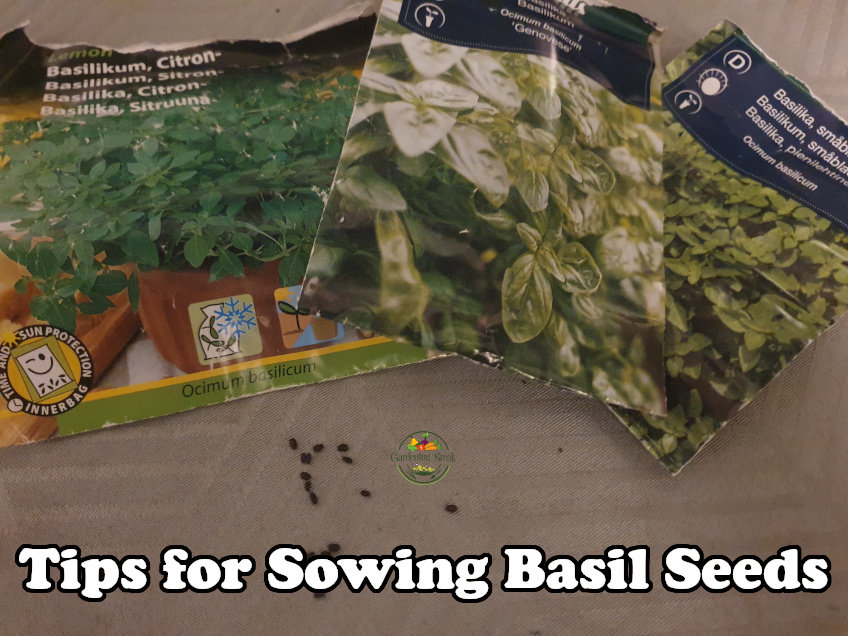
You can sow basil seeds directly in the ground or a large pot, or you can germinate them in small containers and then transplant them into the ground or to a larger pot later.
You can also just spread basil seeds loosely and cover them with a small layer of soil or you can sow them in rows to be a bit more systematic.
The best way to grow basil in rows is to poke several holes that are about half an inch (or about 1 cm) deep in a row with about 12 inches (30 cm) of space between each hole. Then, place 3-5 seeds in each hole and water.
I have a guide where I explain these two methods for sowing basil seeds in greater detail so you can figure out which one fits you the best. You can find the guide on this link where I also dive a bit deeper into the best times to sow basil seeds. Here is a quick summary, though.
Best time to plant basil
The best time to plant basil outside is in the spring, about a month after the last frost. If you want to grow basil indoors in a pot, you can start two weeks earlier. Seedlings can also be started indoors two weeks after the last frost and then transplanted into the garden after 2-3 weeks.
Best place to plant basil
Basil can grow really well both indoors and outside as long as some important conditions are being met. The most important factors that determine whether or not a place is suitable for growing basil are the amount of sunlight it receives, what type of soil there is, and how well it is protected from the wind.
The best place to grow basil outside is protected from too much wind, gets 6-8 hours of sunlight per day, and has nutrient-rich and well-drained soil that ideally has a pH of 6-7.5.
Here are my suggestions for where to place your basil indoors and outside:
Best place to plant basil indoors:
Plant your basil in nutrient-rich and well-drained soil in an 8-inch (or larger) pot near a south-facing (or north if you live south of the equator) window that receives a lot of sunlight.
Best place to plant basil outside:
Plant your basil in nutrient-rich, well-drained soil either in the ground or a pot near a wall or some larger plants that can protect the basil from some wind while still allowing it to get 6-8 hours of sun at the same time. If you also have tomato plants, try to plant some basil underneath them as they grow really well together.
Transplanting basil into the garden or another pot
Transplanting essentially means moving a plant from one place to another, and it is an incredibly useful technique to know about when growing basil or if you want to make a storebought basil plant grow bigger.
These are the steps to transplant basil:
- Get a basil plant, an 8-inch pot, soil, and water
- Fill the pot about halfway with soil
- Carefully remove the basil plant from its old pot
- Gently loosen the basil plant’s roots
- Place the basil plant in the new pot
- Fill the pot with soil around the plant
- Water your basil plant (ideally from the bottom)
I have another post (which you can find here) where I explain each step and show photos of how to do it.
Growing basil in a pot vs. in the ground
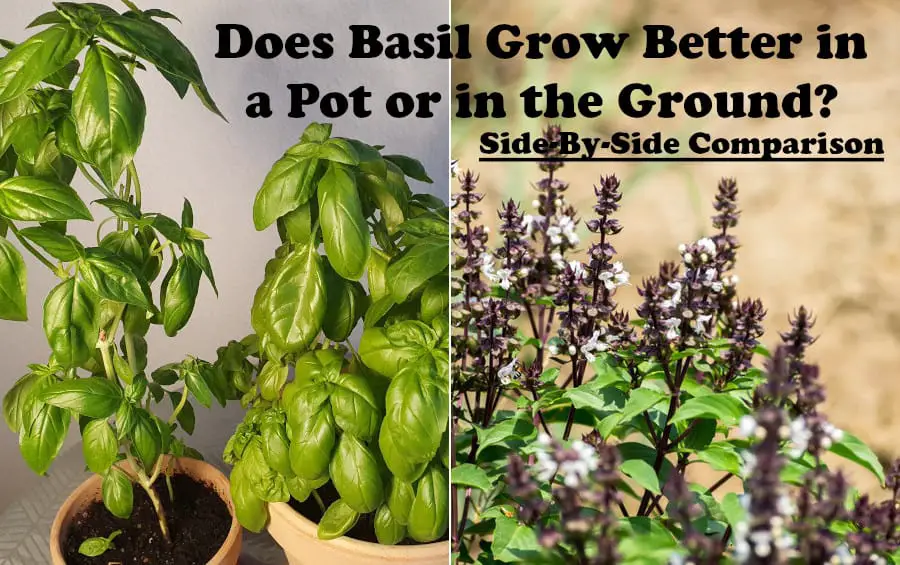
Basil can grow well both when growing in the ground and when growing in a pot or container. Both ways have advantages, for instance, basil plants growing in the ground often get larger than potted basil but are more exposed to pests and give you less control over conditions such as soil type and watering.
To help you decide if you should grow basil in a pot or the ground, I have made a small table with some advantages of each way, so you can choose the one that seems better to you.
| Advantages of growing basil in the ground | Advantages of growing basil in a pot |
| The plants usually get larger than in a pot | The plant can easily be moved around as needed |
| The plant often grows faster than in a pot | It is easier to control how much water it gets |
| It requires less watering than in a pot | It is easier to control what is in the soil |
| The plant cannot get rootbound | The plant is less exposed to pests and diseases |
If you, like me, prefer to grow potted basil, you have to decide if you want to grow it indoors or outside, so I explain the advantages and disadvantages of both below to make the decision as easy as possible for you. If you prefer to grow basil in the ground, this is, of course, not a decision you have to make so just skip ahead.
I have another post (here) where I go into greater detail with a side-by-side comparison of growing basil in a pot compared to the ground.
Growing basil indoors vs. outside
Basil can grow really well both indoors and outside as long as it has the right conditions (which I get into just after this), so you have to consider what you prefer. There are, of course, some advantages and disadvantages of both ways.
| Advantages of growing basil indoors | Advantages of growing basil outside |
| It is easier to control how much water the plant gets | The plant usually gets bigger than indoors |
| The plant is better protected from pests and diseases | The plant usually grows faster than indoors |
| The plant is protected from frost and bad weather | Less watering is required |
| The flowers attract bees which pollinate your garden plants |
The reason why plants outside generally grow faster and get bigger is that they usually have more sunlight and more room for the roots, but as you can see, there are some excellent advantages to growing basil indoors too.
If you are not sure if you should grow basil indoors or outside, I recommend reading this post where I compare the advantages and disadvantages.
Regardless of whether you are growing basil indoors or outside, there are some basic growing conditions that must be met for basil to thrive. I explain everything you need to know about that below.
Best Growing Conditions for Basil
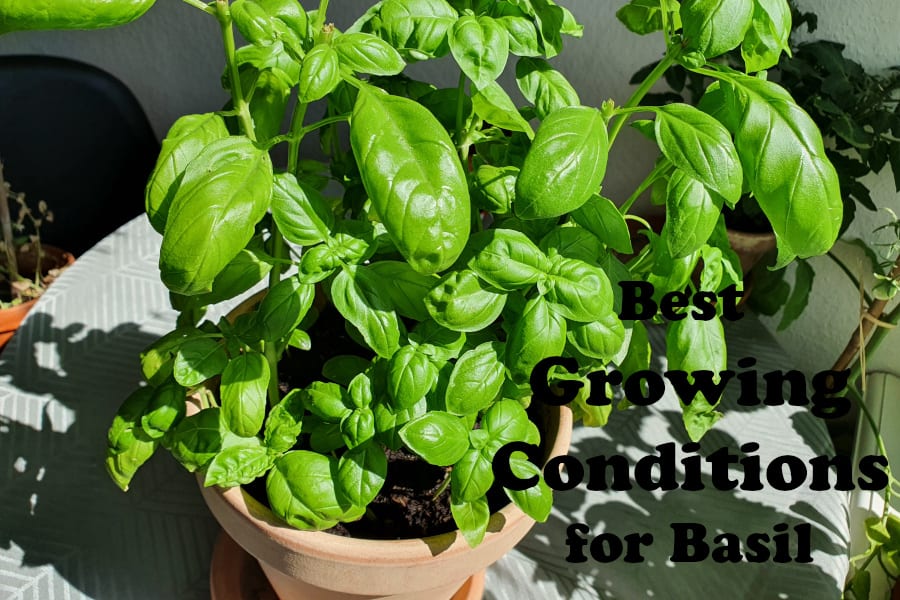
Perhaps the most important thing to know when growing basil is which conditions it needs to grow well. It is not very complicated and can mean the difference between endless supplies of basil and no harvest at all, so let’s get into it.
Sunlight
Basil requires 6-8 hours of sunlight per day during the growing season. Morning sun is optimal since afternoon sun can be too intense. If basil doesn’t get enough sunlight, it will stretch, produce fewer leaves and grow slower. If basil gets too much sunlight, it begins to wilt, and the leaves get brown and dry.
While basil definitely loves lots of sunlight and grows faster and better when it gets lots of it, it can also get too much (read more). Of course, your basil plants should get enough sunlight, or they won’t grow at all, but they also shouldn’t get too much as that can hurt the plants just as much.
The sunlight that reaches your plants is extra intense during the warmest and sunniest weeks of summer but is also generally more intense in the afternoon than in the morning (read more), so I recommend you place your basil strategically, so it gets more sunlight in the morning than in the afternoon, to reduce the risk of the plant taking damage from the sunlight.
Temperature
The ideal temperature for growing basil is 70-85°F (about 21-29°C). It can grow in temperatures as low as 50°F (10°C) and as high as 90°F (32°C), although it will grow slowly at such low temperatures and flower much faster at such high temperatures. Therefore, aim for 70-85°F (about 21-29°) for the best result.
When you grow basil indoors, you don’t have to worry too much about the temperature. In my experience, basil can grow really well at room temperature, and if you place it next to a sunny window (which you should), the plant and the soil will likely be even warmer than the room temperature, which the plant will only benefit from.
When you grow basil outside, the temperature is very important, but you should also not worry if you have one or a few days in a row that are too cold or too warm. As long as it doesn’t get below around 50°F (10°C) and above 90°F (32°C) for too long.
Watering
The best way to water basil is to water it from the bottom whenever the top inch (2.5 cm) of the soil feels dry. Basil requires light but frequent watering, and the soil should be moist and never dry or soaked. Bottom watering promotes root growth and reduces the risk of overwatering.
Instead of watering basil on a fixed schedule, the best way I have found is to lightly touch the top of the soil from the plant to see if it is dry and if it is, then pour water into the plate underneath the pot. If you are growing basil directly in the ground, I still recommend simply touching the soil to see if it is dry, and then just pour the water onto the soil and try to avoid getting it on the leaves.
Basil is thirsty but also easy to overwater, so you should be careful. Watering basil from the bottom can reduce the risk of overwatering, but there are actually also several other excellent benefits to bottom watering, such as increased growth and production. Read more about that here.
Yellow leaves and a wilting plant are two common signs of overwatering. I have written another post (here) where I explain all the signs to look out for to know if you have overwatered your basil and what you should do about it.
Basil is more likely to take damage from overwatering than underwatering, but don’t underestimate underwatering either, as it absolutely can and will kill basil if it goes on for too long. A good trick to help retain some moisture in the soil for longer is to put a layer of mulch on top of the soil around the basil plant. This can also be a good way to fertilize it.
You can read my full guide for correctly watering any basil plant on this link.
Soil
The best soil for basil plants is nutrient-rich, well-drained, sandy loam with a pH between 6.0-7.5. Keep the soil moist and never completely dry or wet as that can cause damage to the plant. Mixing compost into the soil or adding it on top is an excellent way to add nutrients to the soil and fertilize the plant.
When I first started to get into gardening, long before I even got the idea of starting Gardeningbreak, I didn’t think much about what type of soil I used and would usually just use an organic potting mix for most of my plants. That got me pretty far, but I have since learned how much the right soil type can do for your plants and thereby your harvest, so I highly recommend that you consider this when you feel ready for it.
If this all seems too intimidating for now, then don’t worry. Just pick a good organic potting mix, and your basil plants will do just fine. Just make sure wherever you plant your basil is well-drained, as this is crucial when growing basil. A good way to achieve this is to mix some sand into the soil. Potted basil must be in a pot with drainage holes to avoid overwatering, which I wrote about above.
Fertilizer
The best fertilizer for basil is a 5-10-5 organic, liquid fertilizer that is mixed into the water. Fertilize basil sparingly, using about half of what is recommended on the fertilizer container every four to six weeks during the growing season.
A fertilizer with a ratio of 5-10-5 will provide basil plants with the correct amount of the right nutrients (source), but otherwise, a regular all-round, organic, liquid fertilizer also works really well.
I have read a couple of places that claimed that giving basil fertilizer is not necessary, and while I partially agree, my experience tells me that basil plants can benefit a lot and grow both bigger and faster if it is fertilized as described above. If you prefer not to use fertilizer, that is also fine, and your basil will grow just fine without it if you use proper soil, although it won’t get as big as if you use a bit of fertilizer.
The reason I recommend a liquid fertilizer that is mixed into the water is that I find it harder to do wrong than with other types of fertilizer. It is easy to overfertilize and especially when growing basil since it is pretty delicate, but it can’t really go wrong with this type of fertilizer, as long as you use about half of the recommended amount every 4-6 weeks.
Spacing
As a general rule, basil should be planted in groups of 3-5 plants together with 12 inches of spacing between each group. For a larger, bushier basil plant, or for potted basil, seeds can be sown more densely. No matter how you grow your basil, there must be air flow all the way around it.
There are many opinions about how much space basil needs, but to be honest, almost anything works to some degree and what you prefer is the most important factor. If you plant about 3-5 plants per 8-inch pot or per cluster in the ground, you will be sure they have the space they need.
Another commonly recommended way to grow basil is to sow the seeds much more liberally, so you get a lot of plants close together. I personally prefer this as it gives some larger, bushier basil plants that look great, but it really depends on what you prefer. When you do this, it is a really good idea to thin out the plants by removing small stems once in a while to make room for the bigger ones.
It is important to give basil enough space to grow since too little space inhibits growth and eventually stops it entirely. The basil you see in supermarkets is almost always growing in too small pots and will liven up and thrive when transplanted into a bigger pot.
I have another post about the best growing conditions for basil (here) where I go into more depth and share more tips and tricks about sunlight, temperature, watering, soil type, fertilizing, and spacing for basil plants.
Caring for Basil (Pruning, Propagation, Flowering, and More)
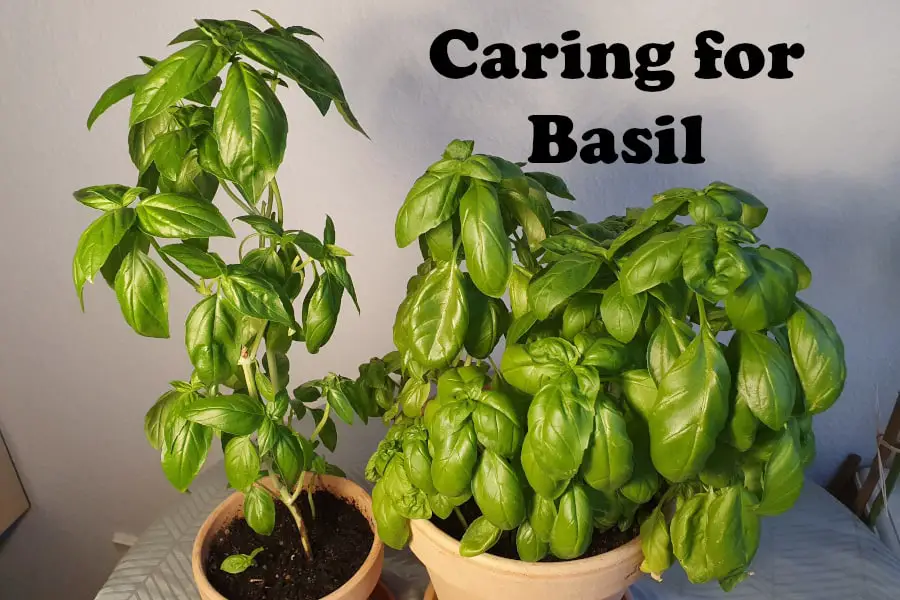
Knowing how to care for basil properly can take your plants and harvest to the next level. Below, I cover pruning and propagation, which are two of the absolute best ways to increase the amount you can harvest. I also cover what happens and what you should do when basil plants begin to flower, how to collect seeds from it, and what other plants are great to grow with basil.
Pruning (easiest way to get much more basil for free)
Pruning essentially means cutting back your plant to promote growth, and while it might seem a bit counterintuitive that cutting a basil plant back can make it produce more, it is actually the best and fastest way to increase your plant’s production and make it bushier. Pruning basil is super easy and essentially the same as harvesting if you know how to do it.
To prune basil, cut the main stems about half an inch (about 1 cm) above sets of leaf nodes. This will cause the stem to split into two and grow as two main stems instead of the original one. There should be at least three leaf nodes before you make the first cut for the best results.
I have a more detailed guide where I explain how to prune basil on this link. I also explain the importance of pruning in the article since there are more good reasons to do it than that the plant will become more productive.
Of course, you can use the stems and leaves you remove from your basil plant in cooking (which is why I compared pruning to harvesting earlier), but another brilliant thing you can do with the cuttings is to propagate them in water to grow them as new plants, thereby increasing your overall production even more. I explain precisely how you do that now.
Propagation (grow more basil plants from cuttings)
Propagation is one of the coolest and most useful gardening techniques. It essentially means taking cuttings from a plant and growing new plants from them. With it, you can essentially turn a single basil plant into as many as you want. The only limiting factor is how long there is enough sunlight, so if you live in an area with enough sunlight all year or if you have some grow lights, you could technically buy or sow a single basil plant and then be self-sufficient in basil forever.
It may sound a bit too good to be true, but it’s really not. It is actually super easy to propagate basil, and once you get started, it won’t be long until your basil production really starts to take off.
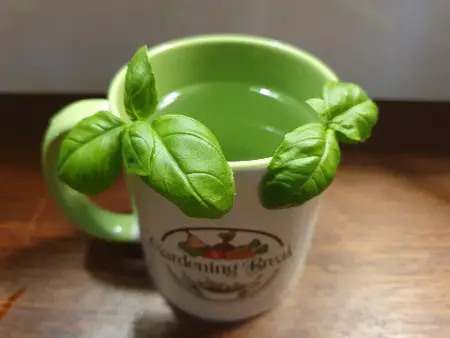
These are the steps to propagate basil:
- Identify new leaf nodes on the plant
- Cut the main stem above the third leaf node
- Remove the lower leaves from the cutting
- Place the cutting in water (only the stem)
- Replace the water every 2-3 days
- Wait 2-3 weeks for roots to grow
- Plant the cutting in soil and water it well
I recommend that you use cuttings that are about 5 inches (about 13 cm) or longer, but you could use even smaller ones, but the way basil propagation works is that the part of the stem that is submerged in water (step 4 above) will begin to grow roots. So the longer the cutting is, the more of it can be underwater and grow roots, and the larger the root system is, the better the plant will grow once you put it in the ground.
It is also really important that you only remove the leaves along the stem and not the 2-4 leaves at the top since the plant needs them to absorb light or it can’t grow.
For a full step-by-step guide to basil propagation with photos of every step of the process, go here.
The fastest way to get more basil than you could ever use
Propagation combined with pruning is the fastest way to multiply your basil production until you have more than you know what to do with. Your basil plants will get more and more productive because you prune them, and you will get more and more plants because you take the cuttings from the pruning and propagate them.
Flowering (what to do when basil flowers)
Basil plants produce beautiful white or purple flowers depending on the variety and how far in they are in the flowering process. Flowering happens towards the end of basil’s lifecycle and is the first step in the production of seeds. The only exception is a few perennial basil varieties that flower every year.

What to do when basil is flowering?
If you are growing basil for the leaves, you should remove the flowers as soon as possible when they begin to appear since the leaves begin to taste bitter when the plant is flowering, and removing the flowers diverts the use of energy back into growing and producing leaves.
If you want to attract bees and other pollinators to your garden or collect seeds from your basil plant, you should let it flower and go through the entire process until the plant begins to dry out and die, at which point the seeds are ready to be collected.
I have written another post (here) to help you decide if removing the flowers from your basil or leaving them is the right thing to do for you.
Basil can still be used when it is flowering, and the flowers are actually edible too, but as mentioned above, the leaves from a basil plant begin to taste bitter when the plant is flowering, so if your plant has already been flowering for a while, I recommend letting it finish flowering so you can collect seeds. I explain how below.
Collecting seeds from a basil plant
Collecting seeds from basil is really easy and one of the best ways to ensure that you can grow much more basil for free. I have a full guide for harvesting basil seeds on this link including how to store them, but if you just want the quick version, here you go.
These are the steps to collect seeds from a basil plant easily:
- Do not prune the plant once it begins flowering
- Let the plant go through the flowering process
- Cut off the entire flower once it is dry
- Place the flower in a warm and dry place
- Wait 1-2 weeks for the flower to fully dry
- Gently remove the dry seeds from the flowers
- Store the seeds in a dry and dark place
Basil plants can spread naturally by producing seeds and dropping them on the ground, although the seeds only germinate in warm areas since frost in the winter will kill them. You can read more about that on this link.
So, the best way to make basil plants spread (if you don’t live in a super warm area) is manually by propagation and collecting seeds.
Companion plants for basil
Companion planting is a technique where you place plants that support each other in different ways near each other. It can be by repelling certain pests, adding certain nutrients to the soil, and more.
Here are some good companion plants for basil and why they are good:
- Asparagus. Asparagus attracts ladybugs which are great for getting rid of aphids which are tiny white, almost transparent-looking, insects.
- Tomatoes. Tomatoes benefit tremendously from growing near basil, as basil can repel some of the pests that commonly attack tomatoes such as tomato hornworms.
- Chilies and peppers. Growing basil near chilies and peppers can help repel some common pests such as aphids, spider mites, mosquitos, and flies.
- Potatoes. Planting basil near potatoes can improve the growth and flavor and also attract a lot of beneficial insects to the garden.
As you can see, knowing what plants to grow together can be an excellent way to avoid certain problems and even increase productivity. Below, I get into how to identify, prevent, and solve some of the common problems you might experience when growing basil.
Common Basil Problems and What to Do About Them
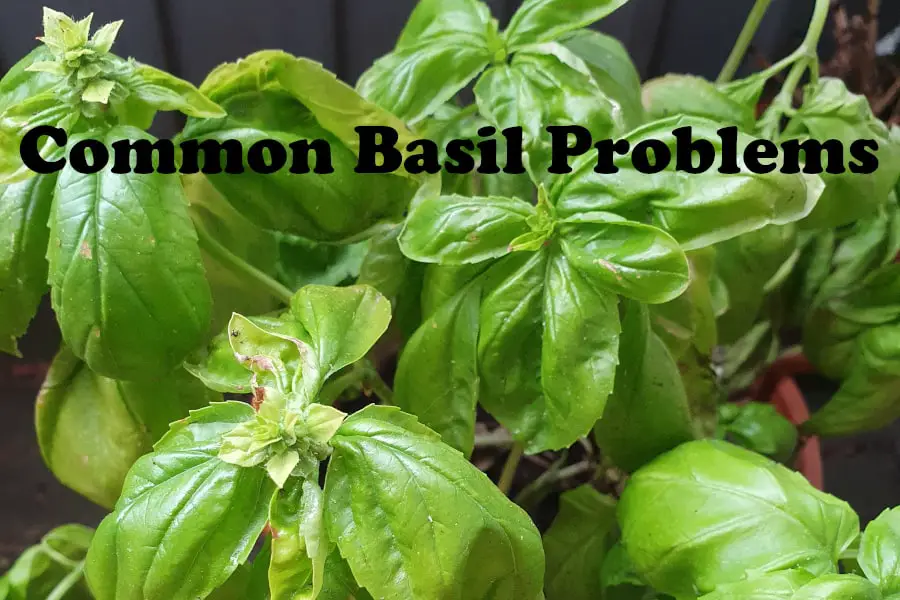
Basil plants don’t usually get attacked by pests and diseases too often, but it does happen, and there are also other common problems people often run into when growing it. Below, I cover some of the common problems and how to take care of them.
A very common issue is that the plant doesn’t grow or the seeds don’t even germinate. I have an article where I cover this issue in detail including causes and solutions, but stay here if that isn’t your problem.
Root rot
Description: Root rot essentially means that the roots of a plant are beginning to rot. It happens when you overwater your basil plants for an extended period of time. When too much of the root system is rotten, the plant will die.
Solution: Transplant your basil plant to another pot if the overwatering is severe. Only water basil when the top of the soil is dry to touch. Water from the bottom to promote root growth.
Rootbound
Description: Basil becomes rootbound when it grows in too little space. What it means is simply that there is no more room for the roots to grow.
Solution: Transplant the basil plant to a bigger pot or into the ground (read more).
Mold
Description: Mold can appear on the top of the soil a basil plant is growing in when it is being kept wet for too long. The mold can spread to the plant and eventually kill it.
Solution: If there is only a little mold that is not touching the plant, gently remove it with a spoon or similar. If there is a lot of mold, transplant the basil to another pot or into the ground. Only water the plant when the top of the soil is dry and water it from the bottom if possible since that reduces the risk of mold (read more).
Leaves not growing
Description: Basil leaves not getting big can be caused by lack of sunlight, lack of water and nutrients, and too little growing space.
Solution: Increase sunlight and water whenever the top of the soil is dry, and fertilize every 4-6 weeks. Transplant to a bigger pot if the growing space is too little (read more).
Aphids
Description: Aphids are tiny white, almost transparent-looking insects that like basil and can quickly multiply and get out of control.
Solution: The best solution is to have some other plants that attract ladybugs and other helpful insects that repel aphids (such as asparagus), but a faster, short-term solution is to use neem oil which is a natural oil that basically coats the plants and makes them unattractive for aphids.
Whiteflies
Description: Looks like tiny white flies that quickly multiply until they take over entire parts of a basil plant.
Solution: The way you deal with whiteflies is similar to how you deal with aphids. The best solution is to have some other plants that attract ladybugs and other helpful insects that repel aphids, but a faster, short-term solution is to use neem oil which is a natural oil that basically coats the plants and makes them unattractive for aphids.
Spider mites
Description: Looks like tiny red spider-like insects. They can be difficult to spot if you’re not specifically looking for them because they are so small. Spider mites drain the nutritious fluids in basil plants which results in the leaves turning yellow and eventually falling off.
Solution: The best, most natural solution to getting rid of spider mites on basil is with ladybugs, lacewings, and other beneficial insects that eat them. A faster way is to fill a spray bottle with water and a few drops of essential oils from rosemary or spearmint and spray it all over the infected plant.
Powdery mildew
Description: Powdery mildew first appears as small white spots around the leaves on basil. It usually begins to appear on the lower leaves first and then moves up towards the top.
Solution: Remove any affected leaves as soon as you notice them. Powdery mildew can sometimes also be treated by mixing one tablespoon of baking soda, a half tablespoon of liquid soap, and a gallon (3.8 liters) of water and spraying it liberally on the affected parts of the plant.
Downy mildew
Description: Downy mildew first appears as small yellow or light green spots around the leaves on basil and can quickly spread to the whole plant. Eventually, the plant will turn brown and die.
Solution: The best solution for dealing with downy mildew is to keep a good eye out for it and remove any leaves that show any symptoms of it before it spreads to the rest of the plant.
These are some of the most common basil problems people experience, but there are more than these, so I recommend reading this post for more info on common basil problems and how to deal with them.
Tips for Harvesting and Storing Basil
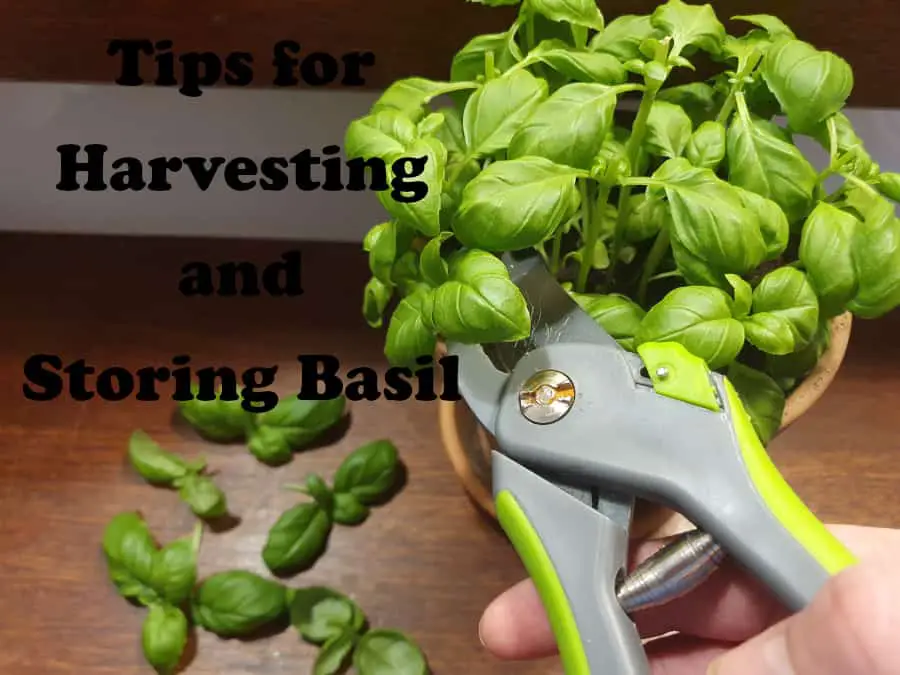
How you harvest basil matters a lot. Using the wrong harvesting technique can stunt the growth of your plants, and using the correct way can multiply your plants’ productivity and be an excellent way to get bigger and bigger harvests.
Other than allowing you to use some of the tasty basil you have grown, frequent harvesting can actually also help fight off diseases and extend the growing season a lot by delaying flowering. So let’s get into it.
Easiest way to harvest basil (so it keeps growing)
The easiest way to harvest basil, so it keeps growing is by cutting stems just above a leaf node. This will cause two new stems to grow out instead of the one that was removed, thereby making the plant bushier and more productive while you get to use the parts you cut off.
The best tip for harvesting basil is to start harvesting early and do it more and more frequently as the plant grows faster and faster. There should be at least three leaf nodes on the stems before you start to harvest from them, though, as it will take too long for them to grow back otherwise.
You can find my guide to harvesting basil on this link, where I share some more useful tips to get the most out of your plants.
In the article, I also explain how to use these four methods for storing all the basil you harvest.
- Hang drying
- Freezing it when it is fresh
- Freezing it in ice cubes
- Freezing it in olive oil
Common Questions About Growing Basil

When I wrote this post, I found a bunch of common questions about growing basil that many people ask very frequently online but didn’t fit into this post before, so I have picked several of them to answer here in a brief and clear way to round off the post. I have also written posts that answer several of them in greater detail and included links to them when relevant.
Q: What should you do with basil plants at the end of the season?
A: It depends on the basil variety you are growing and the climate your live in. Basil is usually grown as an annual plant and in that case, you should make sure to pick any remaining leaves, collect seeds if you want to, and then remove the plant from your garden and prepare the soil for next year.
If you grow a perennial basil variety in a climate where it can live all year, you shouldn’t pick all the leaves or remove it from your garden, but instead, just continue to care for it like normal. You can read more about overwintering basil plants in the article on this link.
If you need more information about what to do with basil at the end of the season, I have a much more detailed answer in the article on this link, where I cover everything you should do depending on your specific situation.
Q: What basil varieties produce the largest and smallest leaves?
A: Green ruffles, Napoletano, and Italian large leaf basil are the three varieties with the largest leaves. With good growing conditions, their leaves can grow to between 4-6 inches (10-15 cm) in length. You can read more about these varieties plus some other large-leaves basil varieties on this link.
The basil varieties with the smallest leaves are Minette basil, Spicy globe basil, and Boxwood basil. Their leaves can be as small as a quarter to half an inch in length (0.6-1.25 cm). You can see more small basil varieties on this link.
Q: How many basil plants should you grow per person?
A: A single basil plant can provide enough for one person for an entire season as long as it is cared for properly. This includes giving it at least 6 hours of sunlight per day and watering it frequently in small doses. Proper pruning is also crucial for getting enough, and propagation is an excellent way to get even more. You can read more about that on this link.
Q: Why is my basil wilting?
A: The most common reason for wilting basil is overwatering but underwatering and overexposure to sunlight can also cause basil plants to wilt. Solve it by making sure the plant gets 6-8 hours of sunlight per day and only water it lightly whenever the top of the soil is dry to the touch. Another potential reason is overfertilization. If that is the issue, some of the leaves will be turning yellow.
Q: Does basil come back every year?
A: Most basil varieties do not come back after the winter since they are annuals, which means that they only live for a single growing season. There are, however, some perennial varieties that can live for several years. You can more about this and see some examples of perennial basil varieties on this link.
Q: How long does it take for basil to grow from seed?
A: Basil seeds usually germinate within a week, and the first leaves can usually be harvested within a month. Flowers typically begin to appear after 3-4 months but may appear earlier or later depending on how much sunlight the plant gets and how warm it is.
Q: Is basil an annual or a perennial?
A: Most basil varieties are annuals, meaning they sprout, grow, flower, produce seeds, and die all within one growing season. There are, however, a few perennial basil varieties, such as Thai basil and African blue basil.
Q: What happens when basil plants are flowering?
A: Flowering marks the transition from the growing stage to the reproduction stage for basil plants. Flower buds and seed pods begin to appear, and you will see stunted growth and leaf production as the energy is diverted toward flowering and seed production. You can read more about that on this link.
Q: Does basil reseed itself and grow back?
A: Basil plants can reseed themselves and grow back next year if the conditions are right. However, the seeds can only withstand mild frost for short periods of time, so basil plants will not reseed themselves and grow back in most parts of the world since it gets too cold in the winter. You can read more about that on this link.
Q Can Basil Survive Without Leaves?
A: Basil plants can sometimes survive without leaves, although it takes a while for new leaves to grow, and in some cases, they won’t and the plant will die. Large plants are much more likely to recover than small plants, and 6-8 hours of sun and consistent watering will further increase the chances of recovery. I made an experiment with one of my basil plants to see if it would survive without leaves. You can see how it went on this link.
Q: Is it possible to save a basil plant that has gotten too much water?
A: It is usually possible to save overwatered basil, although not always. It depends on how severe the damage is. The first thing you should do to save your overwatered basil is to remove any yellow, brown, or dead growth from the plant. You should also allow the top of the soil to dry out before you water it again, but don’t wait too long, because the plant dies if the soil dries out all the way through.
I have a step-by-step guide on how you can save overwatered basil on this link. I show photos of every step of the process to make it as easy as possible.

